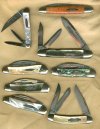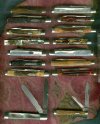Great explanation Dan!
Let's get into it a little more.
Taking some of the above knives as an example you will notice 3 pins going through the handle material. Note that the pin in the middle of the knife is located close to the bottom. That middle pin close to the bottom passes all the way through the knife securing the "back-spring(s) so that the ends of the springs will apply tension to the tang of each blade as it is opened and closed.
The quality of that tension and tang fit to the spring is known as the knife's "walk and talk". Ideally the blade snaps to an open or closed position so the "walk" is the distance that the blade seemingly travels on its own to the open, closed or half-stop (in some cases) position and the talk is the sound or thunk of the blade when it reaches one of those points.
Aside from the regular fit and finish (pins, handle material to frame and bolsters an additional art of the "slipjoint" or multiblade is the the tension of the back-spring against the geometry of the tang. When done right the blade snaps to it's intended position for a significant part of it's travel distance with a distinct sound.
In other words you can open the knife 3/4's of the way and the blade will travel the rest of the way on it's own due to the tension of the spring and the angle of contact of the spring on the tang of the blade. It is a very subtle thing to appreciate, but be careful if this type of thing is something you could get into, slipjoints are addicting

. (Of course what knife is not to most of us.)
Not all slip joints have back-springs, but they all have springs. Some are internal leaf springs as in some models of Swiss Army Knives and other types that are known as barrel and lobster patterns where the leaf springs are internal and hidden by the handle material.
I know there are others who hang around here (makers and collectors as well as Bernard) that can expand or clarify but we have a start as far as a definition. Some of the more knowledgable folks on slipjoints in the world hang around here. (Bernard Levine and Bruce Voyles). Other well known "knife nuts" who have a tremendous amount of knowledge in this area and others are James Parker and Jim Sargent.


